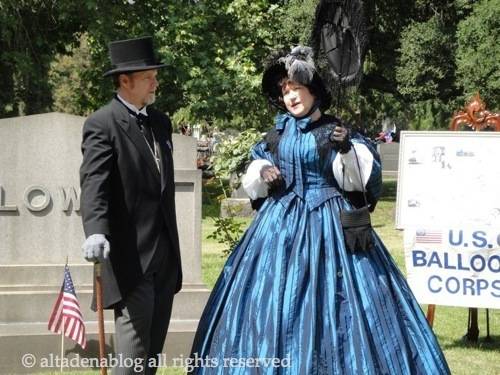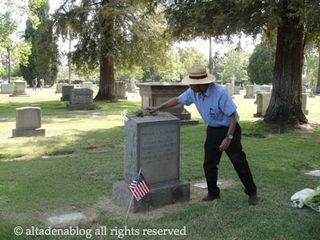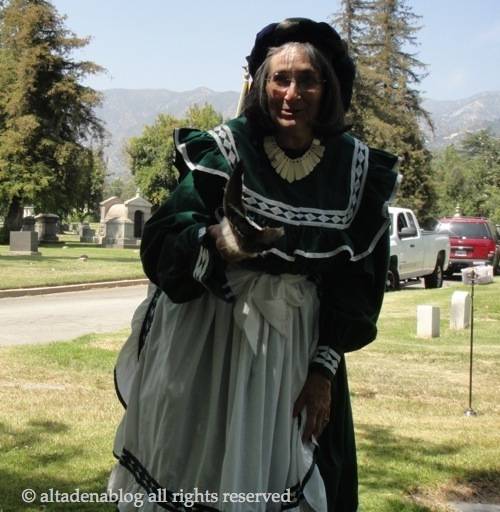
by Laura Monteros
The Civil War divided more than one nation. There was blue and gray, north and south; but the Choctaw nation in Oklahoma was also divided over which side to support. Reenactor Vickie Guagliardo eloquently presented both sides of the story through the viewpoint of a Choctaw matron at the annual Memorial Day commemoration at Mountain View Cemetery on Monday.
Guagliardo was one of several reenactors gathered by Nick Smith of the San Gabriel Valley Civil War Round Table to share little-know aspects of the Civil War. The others were Victorie Milkoff and the MacMillan family, who discussed mourning rituals, and Steve and Patrice Demory as Thaddeus and Leontine Lowe.A daughter of both the Union and Confederacy and descendent of the Choctaw, Guagliardo first took the role of a mother with two sons of warrior age. Confederate Gen. Samuel Cooper had come to Oklahoma with promises to provide guns for defense, money to pay for Choctaw missionaries and other wages and expenses, a seat on the Confederate Congress, and, if they so chose, to become a Confederate state. In the matriarchal society, it was the women who made these decisions. “I said, aye!” she affirmed.
A minute later, she returned as a woman who doubted the promises Cooper made. “Does he come as a friend with his wife and children?” she asked. “No. He comes with guns and men.” It was all talk, she said, noting that Choctaw could get along with their differences. “Can then not white people learn from us?”

Kathy, Robert, and Ian MacMillan and Victorie Milkoff, dressed in mourning, talked about the customs of the time, which were largely influenced by Queen Victoria. Men wore black bands for three months, and then were free to remarry. Women had to wait a year and a day, but many mourned for life. After the Civil War, burial was changed from family plots at home to cemeteries. Wearing jet beads, making jewelry from the hair of the deceased, and taking photos of the dead were contemporary customs.
That charming couple, Thaddeus and Leontine Lowe, entertained visitors at the Lowe family plot. Lowe played a vital tactical role in the Civil War by founding the U.S. Balloon Corps. The gas-filled balloons were stationed over battlefields to relay troop positions to the ground. He got the job after telegraphing President Lincoln from while floating above the White House. &
A prolific inventor, Lowe not only designed a portable hydrogen gas generator to fill balloons in the field, he discovered how to make ice commercially by examining how the air in hot air balloons condensed and became hail. He bragged—in front of the Lowe grave marker, at least—that he invented the air force, built the first aircraft carrier, and developed aerial lighting.
He reported on Bull Run, the Peninsula Campaign, Seven Pines, Sharpsburg, and Fredericksburg. His last report before resigning was to communicate that troops were over the hill to Gettysburg.
Memorial Day in Altadena
The first Memorial Day was instituted by General John A. Logan of the Grand Army of the Republic (GAR)—a fraternal organization similar to the Veterans of Foreign Wars today—who issued a proclamation to member chapters on May 5, 1868, mandating that May 30 be set aside as a day to decorate the graves of the Union dead “while a survivor of the war remains to honor the memory of his departed comrades.”
In Pasadena/Altadena, a parade through town ended with participants riding the trolleys up to Mountain View and laying flowers on the graves of Civil War soldiers until 1946, when 101-year-old veteran Oliver M. Haney made the trip for the last time. A few years ago, the tradition of decorating the graves was revived as an Eagle Scout project, and has taken it up.
There are some 700 Civil War veterans, buried in Mountain View, with about 600 graves currently identified. They served the North and South, and were black, white, and brown. Lt. Thomas Ellsworth, a white man who led the black troops of the 55th Regiment Massachusetts Volunteer Infantry, is buried at Mountain View, as are members of the Mexican division from California. Smith led visitors on a tour of the Union graves, including a portion of the cemetery dedicated to the GAR, and Margaret Alley of the United Daughters of the Confederacy led visitors to the Confederate graves.
During the ceremony, Alley presented the UDC Military Service Award to Vietnam veteran Thomas Chumley, whose ancestors fought on both sides during the Civil War. Tribute was also paid to Civil War nurse Abigail Brown, buried with Civil War soldiers, and the 1st North Carolina Cavalry, representing both Blue and Gray, closed with a gun salute.
- After a quick change, Vickie Guagliardo becomes a Choctaw woman who did not want to side with the Confederates.
- Wreath marking two rows of graves of Civil War veterans, including nurse Abigail Brown.
- Grand Army of the Republic section of Mountain View Cemetery has four rows of graves for GAR members.
- Monument marks the John F. Godfrey Post 93 Grand Republican Army section of Mountain View Cemetery.
- Carole Morton lays flowers on the headstone of Civil War nurse Abigail Brown. The original headstone is missing and was replaced with a modern flat plaque.
- 1st North Carolina Cavalry saluted both the Blue and the Gray.
- Margaret Alley of the United Daughters of the Confederacy presents the UDC Military Service Award to Vietnam veteran Thomas Chumley while Gayle Plunkett looks on.













